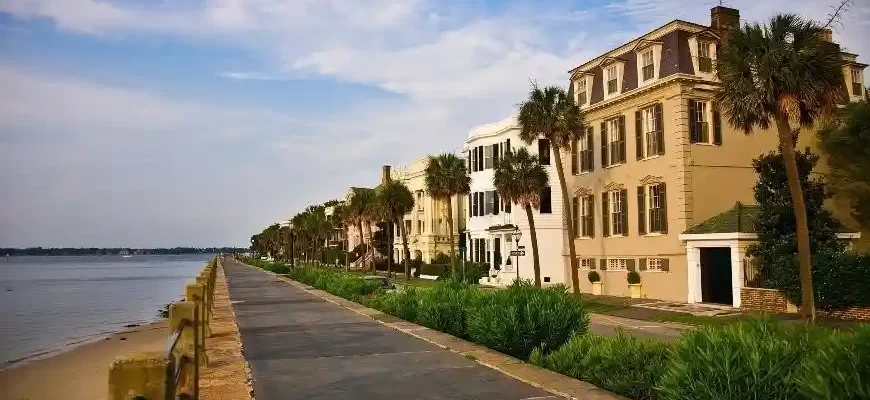Charleston, South Carolina, is known for its rich history, Southern charm, and picturesque landscapes. Among the many iconic spots in this historic city, Charleston Waterfront Park stands out as one of the most beloved public spaces, offering a serene escape with breathtaking views and a vibrant atmosphere. Whether you’re a history buff, a nature lover, or just looking for a relaxing day by the water, Waterfront Park offers something for everyone. This guide will walk you through the unique features of the park, offer practical tips for your visit, and point you toward other exciting things to do in the area.
What Makes Charleston Waterfront Park Special?
Nestled between the Historic District and the Cooper River, Charleston Waterfront Park is a place where nature, history, and art come together in harmony. The park spans over 12 acres and is a serene green space that offers stunning views of the river, an abundance of lush landscaping, and a variety of inviting features. Here are some highlights that make the park so special:
- The Pineapple Fountain: One of the most iconic landmarks of the park, the Pineapple Fountain is a symbol of hospitality, a core value of Charleston. This stunning water feature, made of Charleston gray stone and designed in the shape of a pineapple (a traditional symbol of welcome), is especially famous for its photogenic beauty. Visitors often stop to snap a picture or dip their toes into the cool, cascading water.
- The Waterfront Walkway: For those who enjoy a leisurely stroll, the waterfront promenade runs along the edge of the Cooper River, providing panoramic views of the Charleston Harbor. The walkway is lined with benches where visitors can sit and take in the sights, sounds, and breezes coming off the water. You’ll also spot historical markers and interpretive signs detailing the area’s maritime past.
- The Grand Fountain: Another stunning feature is the large, multi-tiered fountain near the middle of the park. With its elegant design and tranquil sound, it’s the perfect place to relax and unwind. The water features create a peaceful ambiance that invites visitors to linger and enjoy the surroundings.
- Lush Gardens and Landscaping: The park boasts beautiful gardens filled with native plants, towering trees, and winding paths. The seasonal blooms and greenery make it a picturesque spot year-round, with the spring and summer months offering vibrant displays of flowers.
- The Charleston Harbor View: The park’s location on the waterfront provides visitors with spectacular views of the harbor, including ships, historic buildings, and the Arthur Ravenel Jr. Bridge in the distance. This is a prime spot to watch the sunset over the water.
Visitor Tips & Practical Information
- Best Time to Visit: The best time to visit Charleston Waterfront Park is in the spring and fall when the weather is mild and comfortable. Summer can be hot and humid, with temperatures often climbing above 90°F (32°C), so be prepared to stay hydrated and wear sunscreen. Early mornings or late afternoons are ideal for avoiding crowds, especially in the summer.
- Opening Hours: The park is open daily from 6:00 AM to 11:00 PM, making it a great place for an early morning walk or an evening stroll with a view. While the park is always accessible, some of the fountains may be turned off during maintenance or for the winter months.
- Ticket Prices: Free – Yes, you read that right! The park is open to the public and is completely free to visit. It’s a fantastic way to enjoy nature and take in some of Charleston’s best views without spending a dime.
- Accessibility: The park is accessible for all visitors, with wide, smooth pathways suitable for wheelchairs and strollers. Benches are strategically placed throughout the park, providing resting spots for all. The main attractions are also relatively close together, making it easy to explore the park in a short amount of time.

History and Cultural Significance
Charleston Waterfront Park wasn’t always a public park. Before it became a haven for locals and tourists alike, this area was primarily industrial and used for shipping and warehousing. The park was created as part of a larger revitalization effort in the 1980s to reclaim the waterfront for public use.
The park officially opened in 1990, and its design is deeply influenced by Charleston’s history and its relationship to the sea. The graceful water features and lush landscapes evoke the city’s Southern elegance, while the Pineapple Fountain pays homage to Charleston’s history as a center of trade and hospitality. Charleston has long been known as the “Holy City” due to its historical significance and the prominent role that religion played in shaping its development. The park’s creation was part of a broader effort to preserve and celebrate this rich cultural heritage.
What to Expect When You Visit
Walking through the gates of Charleston Waterfront Park, you are greeted by the sweet scent of blooming flowers, the sound of trickling water, and the sight of tall oak trees draped in Spanish moss. The atmosphere is calm, peaceful, and relaxing, offering a stark contrast to the bustle of the nearby streets.
Take a moment to wander the pathways, enjoy the sound of fountains, and perhaps even cool off your feet in the Pineapple Fountain, a favorite among children and families. If you’re visiting in the late afternoon, the park provides one of the best spots to watch a stunning Southern sunset.
For history enthusiasts, the interpretive signs scattered around the park provide a fascinating glimpse into the city’s rich maritime history. These markers highlight Charleston’s role as a key port during the colonial era and offer insight into the lives of those who worked along the waterfront.
Nearby Attractions and Dining Options
Historic Downtown Charleston:
Just a short walk from the park, you’ll find the historic heart of Charleston. Stroll down King Street for shopping, dine in one of the many historic restaurants, or explore the cobblestone streets and charming architecture of the city.
- The Battery and White Point Garden: A beautiful and historic promenade where you can view antebellum mansions, Civil War-era cannons, and the scenic harbor.
- The Charleston City Market: A must-visit for those interested in Charleston’s craft and artisan scene. The market offers everything from local sweetgrass baskets to handmade jewelry.
- Charleston Museum: A short walk away, this museum is one of the oldest in the United States and offers an excellent collection of exhibits on the history of Charleston and the Lowcountry.
For dining, Charleston is a foodie haven. Just a few places near the park include:
- Fleet Landing Restaurant & Bar: Located on the waterfront, Fleet Landing offers great seafood and fantastic views of the harbor.
- Poogan’s Porch: Known for its traditional Lowcountry cuisine, this cozy restaurant is housed in a historic Victorian townhouse.
- 82 Queen: A quintessential Charleston restaurant with Southern staples and an inviting courtyard for al fresco dining.

Family-Friendly and Group Travel Tips
Charleston Waterfront Park is an excellent spot for families with children. The Pineapple Fountain is especially popular with little ones who can splash around and enjoy the cool water. The park’s open spaces and shaded areas also make it a great spot for a family picnic.
For larger groups, the park provides plenty of room for gathering, and the easy access to nearby attractions makes it a great central meeting point. There are often events in the park, such as outdoor concerts and festivals, which can add a fun element to your group outing.
Instagrammable Moments and Photo Opportunities
Looking to capture the perfect shot? Here are some of the best photo ops in the park:
- The Pineapple Fountain – A favorite for photos, particularly with the fountain in full flow against the backdrop of the park.
- The Harbor View – The park offers spectacular views of Charleston Harbor, the waterfront, and the majestic Arthur Ravenel Jr. Bridge in the distance.
- The Grand Fountain – Its classical design and cascading water create a picture-perfect scene for a serene, elegant photo.
- Sunset Shots – The park is an excellent place to catch a stunning Charleston sunset, with its vibrant colors reflected in the water.
Travel Tips and Transportation
- How to Get There: Charleston Waterfront Park is centrally located and within walking distance of many of the city’s top attractions. If you’re staying in the Historic District, you can easily walk to the park. For those coming from farther away, public transportation options, including buses and taxis, are readily available. Biking is also a popular option, as the city has an expanding network of bike lanes.
- Parking: If you’re driving, there are metered parking spots nearby, though they can be limited, especially during peak hours. It’s often easiest to park a little farther away and walk to the park.
Safety and Etiquette Tips
- Stay Hydrated: Charleston can get hot, especially in the summer months. Be sure to bring water to stay hydrated.
- Respect Local Wildlife: While you’ll likely see birds, squirrels, and other small animals, it’s best to observe them from a distance and avoid feeding them.
- Leave No Trace: Keep the park clean by disposing of trash in the designated bins. Charleston takes pride in its beauty, and visitors are expected to do the same.
- Quiet Hours: While the park is generally peaceful, avoid loud noise or disruptions as it’s a place for relaxation.
Fun Facts and Incidents
While there aren’t many outlandish tales tied to the Waterfront Park itself, it’s worth noting that the park has hosted various special events over the years, including historic commemorations and citywide celebrations. One fun fact: the Pineapple Fountain was designed with Charleston’s steamy summers in mind – it’s purposefully designed as a fountain you can interact with, offering relief on those hot days!









